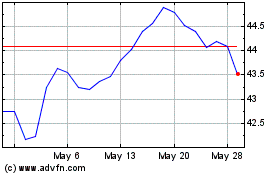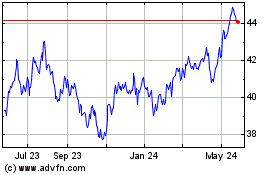Can the Malaysia ETF Bounce Back in 2014? - ETF News And Commentary
20 December 2013 - 2:00AM
Zacks
The Malaysia ETF has gone through a rough patch in 2013. Political
uncertainty in the initial phase, and then the expected cease of
cheap dollars on the ‘Taper’ concern as well as slow-but-steady
growth in the U.S. against a relative slowdown in emerging markets
–played a big role in upsetting the country.
The World Bank also slashed its growth forecast for the Malaysian
economy in early October to 4.3% for 2013 and to 4.8% for
2014. Prior to this, the World Bank trimmed its Malaysian forecast
to 5.1% from 5.6% in late-July, citing current-account woes first
time since 1997.
However, the scenario seems to have taken a turn just before the
New Year. This is evident from the pretty decent economic scorecard
posted recently by the third largest Southeast Asian economy (read:
Malaysia ETF Surges on Election Result).
Export Boom Grabs Attention
Malaysia's exports jumped 9.6% year over year in October against a
forecast of 6.1% growth thanks to the recovery in its major trading
partners – China, ASEAN, Australia, the European Union, Hong Kong,
Korea and India. October numbers – representing a five successive
month of expansion – went up 6.1% sequentially.
Import growth (13.9%) in the month-under-review more than doubled
from the economists’ expectation. This was driven by increases in
imports of intermediate goods which should give another boost to
the exports in the final two months of the year.
Exports comprise more than half of Malaysia’s GDP thus becoming
instrumental in driving economic activity. The nation’s
FTSE Bursa Malaysia KLCI Index climbed to a record
high following the export data release.
The country’s trade surplus remains steady. Malaysia is one of the
only countries in Southeast Asia that has a decent current account
balance at present. Though many had expected the country to fall
into a deficit trap due to poor exports earlier this year, Malaysia
narrowly escaped that and is now comfortably in the surplus
zone.
GDP Picture ‘Not-So-Bad’
Malaysian GDP growth speeded up to 1.7% on a quarter-on-quarter
basis in Q3, up from 1.4% recorded in Q2. Improvement in private
investment coupled with the surge in net exports aided the economic
output.
This trend should continue even in the final quarter of the year as
the country fared better in terms of industrial production in
October, with 1.7% year-over-year and 0.7% sequential growth.
Notably, economists expected the industrial activity to slump 0.8%
quarter-on-quarter.
The government is also implementing a goods and services tax to
reduce the fiscal deficit. The country’s finance ministry issued
growth guidance in late October which assumes 4.5–5% economic
expansion this year and 5–5.5% in the next. No matter how the
economy is rolling, the GDP growth expectation is surely better
than many developed nations as well as developing ones in the
region too.
Decline in Debt-to-GDP Ratio
A much alarming component in the Malaysian economy was a high debt
to GDP ratio, be it on government (~50% in 2012) or household (~80%
in 2012). Some even believe that this sky-high credit level is
basically facilitating Malaysia’s economy to grow around 6% range
in the recent years.
However, the nation progressed on this front as well, though a
little bit. The rise of the household debt-to-GDP ratio fell to
2.5% in Q3 from 3.2% in the preceding period thanks to the central
bank’s measure. Also, as a relief, the amount of non-performing
loans remains low among household indebtedness (read: Time to Buy
the Top Ranked Malaysia ETF?).
Given these trends, a look to a Malaysian investment might be an
intriguing idea. Fortunately, investors have this with the
Malaysia ETF, which we have described in greater detail below:
iShares MSCI Malaysia ETF
(EWM) in Focus
The fund looks to track the performance of the Malaysian equity
market. The fund invests about $853 million in assets in 44
holdings. The fund is concentrated in the top 10 holdings which
account for as much as about half of the total.
The ETF charges a reasonable 49 bps in annual fees. The fund is
heavily exposed to financials that make up for about 30% of the
share in the basket followed by the industrials and utilities
sectors (see more in the Zacks ETF Center).
The most striking part is the fund’s return. EWM added about 11.2%
in the year-to-date frame (as of December 10) while the broader
emerging markets funds like
Vanguard FTSE Emerging Markets
ETF (VWO) and
iShares MSCI Emerging Markets Index Fund
(EEM) lost 1.15% and
0.43% respectively. EWM currently has a Zacks ETF Rank #3
(Hold).
Conclusion
While things are not yet fully over the hump, the country might be
an intriguing pick for investors planning a portfolio reshuffle
going into the New Year.
Yes, the taper issue is looming large, but we believe analysts have
already adjusted this much-hyped concern in their forecasts. And
even after the adjustment – which should take into account reduced
investment – forecasts look fairly encouraging compared to many
other emerging nations, suggesting that EWM might be a solid choice
for 2014.
Want the latest recommendations from Zacks Investment Research?
Today, you can download
7 Best Stocks for the Next 30
Days. Click to get this free report >>
ISHARS-EMG MKT (EEM): ETF Research Reports
ISHARS-MALAYSIA (EWM): ETF Research Reports
VANGD-FTSE EM (VWO): ETF Research Reports
To read this article on Zacks.com click here.
Zacks Investment Research
Want the latest recommendations from Zacks Investment Research?
Today, you can download 7 Best Stocks for the Next 30 Days. Click
to get this free report
Vanguard FTSE Emerging M... (AMEX:VWO)
Historical Stock Chart
From Jan 2025 to Feb 2025

Vanguard FTSE Emerging M... (AMEX:VWO)
Historical Stock Chart
From Feb 2024 to Feb 2025
